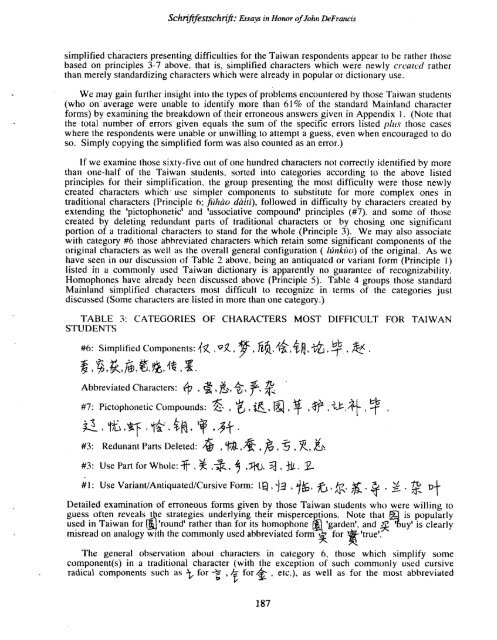Essays on Writing and Language in Honor - Sino-Platonic Papers
Essays on Writing and Language in Honor - Sino-Platonic Papers
Essays on Writing and Language in Honor - Sino-Platonic Papers
Create successful ePaper yourself
Turn your PDF publications into a flip-book with our unique Google optimized e-Paper software.
Schnfffes~ch n'!: <str<strong>on</strong>g>Essays</str<strong>on</strong>g> <strong>in</strong> H<strong>on</strong>or of John &Francis<br />
simplified characters present<strong>in</strong>g difficulties for the Taiwan resp<strong>on</strong>dents appear to be rather those<br />
based <strong>on</strong> pr<strong>in</strong>ciples 3-7 above, that is. simplified characters which were newly o-eated rather<br />
than merely st<strong>and</strong>ardiz<strong>in</strong>g characters which were already <strong>in</strong> popular or dicti<strong>on</strong>ary use.<br />
We may ga<strong>in</strong> further <strong>in</strong>sight <strong>in</strong>to the types of problems encountered by those Taiwan students<br />
(who <strong>on</strong>'average were unable to identify more than 61% of the st<strong>and</strong>ard Ma<strong>in</strong>l<strong>and</strong> character<br />
forms) by exam<strong>in</strong><strong>in</strong>g the breakdown of their err<strong>on</strong>eous answers given <strong>in</strong> Appendix 1. (Note that<br />
the total number of errors given equals the sum of the specific errors listed 11llrs those cases<br />
where the resp<strong>on</strong>dents were unable or unwill<strong>in</strong>g to attempt a guess, even when encouraged to do<br />
so. Simply copy<strong>in</strong>g the simplified form was also counted as an error.)<br />
If we exam<strong>in</strong>e those sixty-five out of <strong>on</strong>e hundred characters not correctly idenlified by more<br />
than <strong>on</strong>e-half of the Taiwan students. sorted <strong>in</strong>to categories accord<strong>in</strong>g to the above listed<br />
pr<strong>in</strong>ciples for their simplificati<strong>on</strong>, the group present<strong>in</strong>g the most difficulty were those newly<br />
created characters which use simpler comp<strong>on</strong>ents to substitute for more complex <strong>on</strong>es <strong>in</strong><br />
traditi<strong>on</strong>al characters (Pr<strong>in</strong>ciple 6: frihao driiri), followed <strong>in</strong> difficulty by characters created by<br />
extend<strong>in</strong>g the 'pictoph<strong>on</strong>etic' <strong>and</strong> 'associative compound' pr<strong>in</strong>ciples (#7). <strong>and</strong> some of those<br />
created by delet<strong>in</strong>g redundant parts of traditi<strong>on</strong>al characters or by chos<strong>in</strong>g <strong>on</strong>e significant<br />
porti<strong>on</strong> of a traditi<strong>on</strong>al characters to st<strong>and</strong> for the whole (Pr<strong>in</strong>ciple 3). We may also associate<br />
with category #6 those abbreviated characters which reta<strong>in</strong> some significant comp<strong>on</strong>ents of the<br />
orig<strong>in</strong>al characters as well as the overall general c<strong>on</strong>figurati<strong>on</strong> ( lhkiro) of the orig<strong>in</strong>al. As we<br />
have seen <strong>in</strong> our discussi<strong>on</strong> of Table 2 above, be<strong>in</strong>g an antiquated or variant form (Pr<strong>in</strong>ciple I)<br />
listed <strong>in</strong> a comm<strong>on</strong>ly used Taiwan dicti<strong>on</strong>ary is apparently no guarantee of recognizability.<br />
Homoph<strong>on</strong>es have already been discussed above (Pr<strong>in</strong>ciple 5). Table I groups those st<strong>and</strong>ard<br />
Ma<strong>in</strong>l<strong>and</strong> simplified characters most difficult to recognize <strong>in</strong> terms of the categories just<br />
discussed (Some characters are listed <strong>in</strong> more than <strong>on</strong>e category.)<br />
TABLE 3: CATEGORIES OF CHARACTERS MOST DIFFICULT FOR TAIWAN<br />
STUDENTS<br />
#6: Simplified Comp<strong>on</strong>ents: 4~ . ~ 2 ,<br />
$ ,%a.<br />
Abbreviated Characters: @ , g, s7 @, p, q---- * -<br />
#7: Pictoph<strong>on</strong>etic Compounds: g- , $ , c,<br />
& .<br />
'&,$h, &, 9,<br />
a ,y , @ , %k,2+<br />
, ,<br />
#3: Redunant Parts Deleted: 4 '@).,a<br />
, ,$, 3 , x, ,&><br />
#3: Use Part for 'Whole: lfF . 2 ,%, 9 ,my 4 , ~.<br />
#I: Use VariantiAntiquatediCursive Form: 14 . J3 , r/&, 6, $, 5, $ ,<br />
? ?$ D*<br />
Detailed exam<strong>in</strong>ati<strong>on</strong> of err<strong>on</strong>eous forms given by those Taiwan students who were will<strong>in</strong>g to<br />
guess often reveals t e strategies underly<strong>in</strong>g their rnispercepti<strong>on</strong>s.<br />
used <strong>in</strong> Taiwan for @$round' rather than for its homoph<strong>on</strong>e @ 'garden', Note <strong>and</strong> that<br />
misread <strong>on</strong> analogy with the comm<strong>on</strong>ly used abbreviated form for %&-'true1.<br />
is popularly<br />
uy' is clearly<br />
A<br />
The general observati<strong>on</strong> about characters <strong>in</strong> category 6, those which simplify some<br />
comp<strong>on</strong>ent(s) <strong>in</strong> a traditi<strong>on</strong>al character (with the excepti<strong>on</strong> of such comm<strong>on</strong>ly used cursive<br />
radical comp<strong>on</strong>ents such as t for + , k for & . etc.). as well as for the most abbreviated<br />
@ F

















